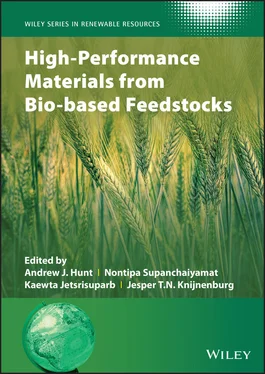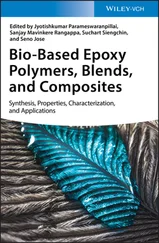High-Performance Materials from Bio-based Feedstocks
Здесь есть возможность читать онлайн «High-Performance Materials from Bio-based Feedstocks» — ознакомительный отрывок электронной книги совершенно бесплатно, а после прочтения отрывка купить полную версию. В некоторых случаях можно слушать аудио, скачать через торрент в формате fb2 и присутствует краткое содержание. Жанр: unrecognised, на английском языке. Описание произведения, (предисловие) а так же отзывы посетителей доступны на портале библиотеки ЛибКат.
- Название:High-Performance Materials from Bio-based Feedstocks
- Автор:
- Жанр:
- Год:неизвестен
- ISBN:нет данных
- Рейтинг книги:5 / 5. Голосов: 1
-
Избранное:Добавить в избранное
- Отзывы:
-
Ваша оценка:
- 100
- 1
- 2
- 3
- 4
- 5
High-Performance Materials from Bio-based Feedstocks: краткое содержание, описание и аннотация
Предлагаем к чтению аннотацию, описание, краткое содержание или предисловие (зависит от того, что написал сам автор книги «High-Performance Materials from Bio-based Feedstocks»). Если вы не нашли необходимую информацию о книге — напишите в комментариях, мы постараемся отыскать её.
High-Performance Materials from Bio-based Feedstocks
The latest advancements in the production, properties, and performance of bio-based feedstock materials
www.wiley.com/go/rrs High-Performance Materials from Bio-based Feedstocks
High-Performance Materials from Bio-based Feedstocks
High-Performance Materials from Bio-based Feedstocks — читать онлайн ознакомительный отрывок
Ниже представлен текст книги, разбитый по страницам. Система сохранения места последней прочитанной страницы, позволяет с удобством читать онлайн бесплатно книгу «High-Performance Materials from Bio-based Feedstocks», без необходимости каждый раз заново искать на чём Вы остановились. Поставьте закладку, и сможете в любой момент перейти на страницу, на которой закончили чтение.
Интервал:
Закладка:
For both the sulphur‐containing gases, adsorption ability was dominated by the highest temperature materials (in this case, 800 °C was the maximum used). Indeed, for hydrogen sulphide, the pectin‐derived materials were exceptionally active, adsorbing 20 times as much as any other material tested, and approximately 4 times as much as a pectin‐derived P550 material. Interestingly, XPS studies on the loaded samples showed that, while most of the sulphur loaded was in the original oxidation state, there were significant quantities of oxidised sulphur species present (S(IV) and S(VI)). Small amounts of reduced sulphur species were noted on SO 2adsorption, along with more prevalent oxidised species. The presence of high oxidation state N species in very low quantities on the surface of the materials was suggested as a potential catalytic route to oxidation of the S species. The significant amounts of inorganics in the materials may also play a role, especially in the high‐temperature materials, where the inorganics are concentrated via loss of organics – S800 has only 2.6% inorganics, A800 a significant 8.8%, and P800 (from pectin) a huge 28.6%, much of it potassium.
Dura et al. published results relating to the impressive ability of Starbon to adsorb carbon dioxide, which is an important topic for control of CO 2levels and also to concentrate CO 2prior to its conversion into valuable chemicals such as cyclic carbonates [35]. The authors compared the predominantly mesoporous Starbon (68–92% of the total pore volume was in the mesopore range) with Norit‐activated carbon which is c. 75% microporous. They utilised both starch‐based and alginic‐acid‐derived materials in their study, and these were prepared over a wide temperature range from 300 to 1200 °C.
Pressure swing adsorption data were collected over 5 cycles at 10 bar pressure. This demonstrated that, in both the starch‐ and alginic‐acid‐derived materials, CO 2adsorption increased from low levels for the S300 and A300, reaching a maximum at the S800 and A800 materials. Beyond the 800 materials, there was a slight drop in the case of the starch materials, but a substantial reduction in adsorption in the alginic acid series. The optimal adsorption capacity was 40% (S800) and 50% greater (A800) than for Norit. Adsorption kinetics were the same for all three adsorbents, with saturation after 30 minutes at 5 bar pressure or after 10 minutes for 10 bar pressure. Desorption under atmospheric pressure took 20 minutes in all cases.
Simultaneous thermal analysis was used to measure adsorption/desorption under flowing conditions alternating between CO 2and nitrogen. This indicated rapid and complete reversibility of adsorption over many cycles, as well as allowing estimation of the enthalpy of adsorption. The values (between −14 and −18 kJ mol −1) indicate that physisorption is the predominant mechanism. Regression analysis was used to develop an empirical equation to correlate the adsorption to textural properties and led to the equation:

In other words, the adsorption behaviour is strongly linked both to micropore adsorption and to a combination of micropores and mesopores, suggesting that the combination of mesopores and micropores allows excellent transport to the adsorption sites as well as some mesopore adsorption.
Very importantly, CO 2to nitrogen selectivity was measured for Norit, S800 and A800 using mixed gas streams at 298 and 323 K. What was striking here was that selectivity to CO 2was much higher for the Starbon materials (14.0–20.3) than for Norit (5.4 at 298 K and 4.0 at 323 K) meaning that adsorption in real situations would benefit from the use of the Starbon materials.
3.2.4.2 Adsorption or Organics from Solution
Parker et al. [36] demonstrated that Starbon materials have a very impressive ability to adsorb a range of small phenolic molecules from water. They chose the relatively hydrophobic and low oxygen content Starbon‐800 materials as their adsorbents, and compared starch‐derived systems with alginic‐acid‐derived systems. Both materials exhibited equally good adsorbency behaviour over a range of phenols in an aqueous solution ( Table 3.4). The starch‐derived S800 had around twice the surface area of the alginate A800, but much of the ‘extra’ surface area was present as micropores and ultramicropores, which likely contribute less to the adsorption behaviour. It is tempting to think that the process is therefore as simple as being directly related to a similar mesopore surface area; however, a more detailed analysis of the relevant adsorption isotherms indicated that somewhat more complexity is involved.
Table 3.4 Collected data for the adsorption of phenols on alginic‐acid‐derived Starbon (A) and on starch‐derived Starbon (S).
Source: Data from Parker et al. [36].
| Phenol | ΔG (kJ mol −1) | ΔH (kJ mol −1) | ΔS (J mol −1K −1) | Q o(mg g −1) | n | |||||
|---|---|---|---|---|---|---|---|---|---|---|
| A | S | A | S | A | S | A | S | A | S | |
| H‐ | −0.13 | −0.91 | 1.7 | −3.8 | 6.0 | −9.7 | 40.3 | 100 | 0.03 | 5.7 |
| 2‐Me | −2.8 | −1.6 | −16 | 4.2 | −4.3 | 20 | 0.08 | 94.6 | 3.6 | 5.8 |
| 2‐F | −2.0 | −2.5 | −11 | −4.1 | −32 | −5.4 | 206 | 131.8 | 0.01 | 6 |
| 3‐NH 2 | −0.42 | −0.57 | 8.9 | −1.8 | 32 | −4.0 | 241 | 101.2 | 0.01 | 6.6 |
| 4‐OMe | −1.2 | −2.8 | 37 | −4.9 | 128 | −6.9 | 146 | 118.6 | 3.8 | 14.1 |
First, using Langmuir and Freundlich isotherms, it was postulated that the surfaces have significant heterogeneity, with some residual oxygen functionality being responsible for the heterogeneous surface energy. Physisorption was also indicated by the isotherms (via heterogeneity factor and adsorption energy values). Perhaps, unsurprisingly, for systems where mesoporosity is important, multilayer adsorption is evident, with all systems going well beyond surface coverage. What is surprising is that, despite the similar capacities of the two materials, the monolayer adsorption capacities are similar for all phenols for S800, but vary significantly for the same molecules in the case of A800. Similarly, the thermodynamic parameters for the adsorption of S800 and A800 are very different, suggesting a quite different mode of adsorption within the group of phenolics, with some being entropy‐driven (approximating to release of waters of hydration at the surface/around the phenol) and others enthalpic (stabilising interactions between surface and adsorbate). A positive contribution to the adsorption via entropy seems more prevalent in the alginic acid series of adsorbents.
The same group, in collaboration with a group at Menoufia University in Egypt, also examined the potential of Starbon materials in decontaminating grey water from laundrettes. This is the post‐wash waters that are expelled from washing machines and which are contaminated with suspended solids, minerals such as potassium and phosphate, as well as detergent molecules and aggregates. Re‐use of the very substantial quantities of grey water would go a long way to reducing the water requirements of large conurbations.
The first paper [37] focused on a combination of Fentons reagent (Fe(III) and hydrogen peroxide) with Starbon‐300 to clean up grey water by a combination of oxidation and adsorption. Chemical oxygen demand (COD) reduction was used as a determinant of success. A series of operating parameters were investigated for each of the two components separately, and then the optimum combination of the two was investigated. For the Fenton’s reagent and hydrogen peroxide system, optimal iron and hydrogen peroxide concentrations were determined beyond which efficiency dropped significantly. The influence of pH was also investigated, and a definite trend was seen with lower pH values giving significantly better results. This is attributed to the role of pH in guiding the relatively complex Fenton’s chemistry to the highest production of hydroxyl radicals, the most active species. For adsorption on Starbon, similarly acidic conditions were optimal for adsorption of materials and reduction in COD.
Читать дальшеИнтервал:
Закладка:
Похожие книги на «High-Performance Materials from Bio-based Feedstocks»
Представляем Вашему вниманию похожие книги на «High-Performance Materials from Bio-based Feedstocks» списком для выбора. Мы отобрали схожую по названию и смыслу литературу в надежде предоставить читателям больше вариантов отыскать новые, интересные, ещё непрочитанные произведения.
Обсуждение, отзывы о книге «High-Performance Materials from Bio-based Feedstocks» и просто собственные мнения читателей. Оставьте ваши комментарии, напишите, что Вы думаете о произведении, его смысле или главных героях. Укажите что конкретно понравилось, а что нет, и почему Вы так считаете.












